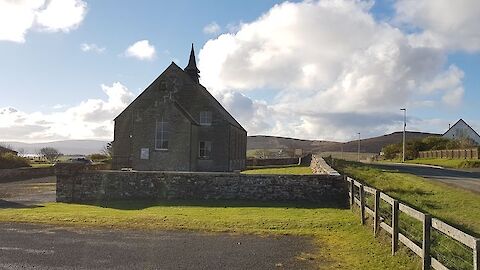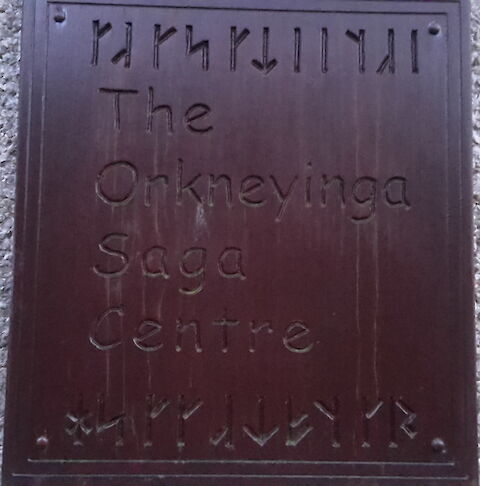Here you can find the resources we are developing for the journey. Many of these are linked to the smartphone app.
61 resources were found:
Mansie stones mark resting stones where Magnus's body was laid. The first resting place is a green mound in Evie and is the likely landing place of the body. It may or may not be the Broch of Gurness - listen on to hear more about this.
Historical information about Gurness
Excerpt from the Magnus Saga on the death of Magnus
Excerpt from the Magnus Saga on the death of Magnus
Historical information about Evie Old Parish Church and cemetery
Historical information about Evie Old Parish Church and cemetery
Historical information about the Knowe of Stenso
Historical information about the Knowe of Stenso
Historical information about St Peter's Kirk in Costa
Historical information about St Peter's Kirk in Costa
Historical information about Chrismo
Historical information about Chrismo
Historical information about the Mans Stane at Loch of Swannay
Historical information about the Mans Stane at Loch of Swannay
Historical information about the Mans Stane at Knowe of Lingro
Historical information about the Mans Stane at Knowes of Lingro
Historical information about the Mans Stanes at Northside in Birsay
Historical information about the Mans Stanes at Northside in Birsay
Historical information about St Magnus Church, Birsay
Historical information about St Magnus Church, Birsay
Historical information about the Mans Well in Birsay.
Historical information about the Mans Stone at Strathyre
Historical information about Twatt Church, Birsay
Historical information about Wheebin Standing Stone.
Historical information about Kirbuster.
Historical information about Saevar Howe.
Historical information about Housby
Historical information about Greenay
Historical information about Birsay.
Audio recording of historical information about Kingshouse, Harray, where an unknown mound (visible to the southeast of North Bigging) is traditionally associated with a resting place of St Magnus.
Audio recording of historical information about the Knowes of Conyar, also known as St Magnus's Resting Place.
Audio recording of historical information about St Michael's Kirk in Harray.
Audio recording of historical information about Appiehouse as a possible resting point.
There is a rich Magnus tradition associated with an 8ft high standing stone on the top of Stoney Hill in Harray. This prehistoric stone, is the only remaining stone from a stone circle that once dominated the skyline.
There are two places in the south corner of Harray which have been suggested as resting places of Magnus: A mound called Howinawheel on the land of Winksetter and a stone at or near The Refuge. There is about a mile distance between these two places and the traditions for both rely on place-name evidence.
A small artificial island in the Loch of Wasdale (in the parish of Firth), once reached by means of submerged stepping stones, is the site of a chapel. This chapel, for which no dedication survives, has no associated burial ground, which is unusual.
The first Magnus resting place in Firth was thought to be a mound ‘somewhat to the west of Finstown with a standing stone on top’.
An interesting tradition concerning a Mans Stane in the heart of Finstown.
The name Whilcoe, now Quilco and the name of a housing estate, referred at the end of the nineteenth century to a boundary stone marking the three parishes of Birsay, Harray and Sandwick.
There are various traditions associated with the transportation of that Magnus’s shrine through the parish of Harray on the way from Birsay to Kirkwall.

Close up of runestone inscription. Image © www.theorcadianphotos.co.uk

The Naversdale Runestone Image © www.theorcadianphotos.co.uk
Historical information about the Naversdale Runestone, discovered in 2013.
Historical information about the island of Damsay in the Bay of Firth.
Historical information about the Earl's Bu and Round Kirk in Orphir.
Historical information about the house of Oback.
Historical information about the Earl's Bu and Round Kirk in Orphir.
Historical information on how the bones of Magnus came to be in the Cathedral, were thought lost after the Reformation and then rediscovered in the 1920s.
Historical information about St Olaf's Kirk, where Magnus's bones were brought to from Birsay before the Cathedral was ready.
Historical information about St Magnus Cathedral.
Birsay, the ancient capital of Orkney was the residence of Earl Thorfinn the Mighty. Listen to find out more.

A photograph of Orphir Kirk.
A short overview of Birsay's significance as the seat of the Earls of Orkney up until the death and reinterment of St Magnus in the 12th century.
A short overview of the historical significance of the Mans Stones and the Strathyre stone in particular.
An overview of the origins of Kirbuster as derived from its etymology and historical location.
Description and history of the St Magnus Church, Egilsay
More information about St Magnus
The story of St Nicolas Kirk, the 'Roond Kirk' in Orphir







